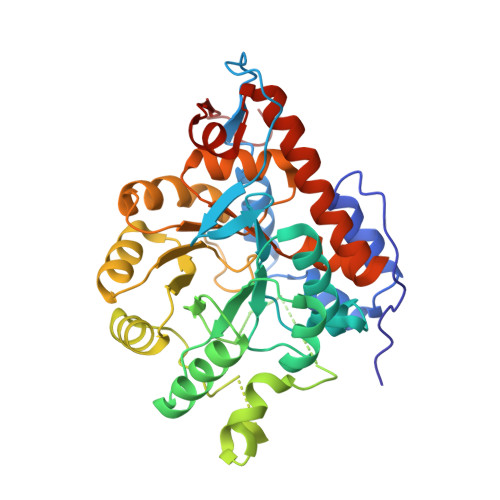X-ray structures of Aerococcus viridans lactate oxidase and its complex with D-lactate at pH 4.5 show an alpha-hydroxyacid oxidation mechanism
Furuichi, M., Suzuki, N., Dhakshnamoorhty, B., Minagawa, H., Yamagishi, R., Watanabe, Y., Goto, Y., Kaneko, H., Yoshida, Y., Yagi, H., Waga, I., Kumar, P.K.R., Mizuno, H.(2008) J Mol Biology 378: 436-446
- PubMed: 18367206
- DOI: https://doi.org/10.1016/j.jmb.2008.02.062
- Primary Citation of Related Structures:
2NLI, 2ZFA - PubMed Abstract:
L-Lactate oxidase (LOX) belongs to a family of flavin mononucleotide (FMN)-dependent alpha-hydroxy acid-oxidizing enzymes. Previously, the crystal structure of LOX (pH 8.0) from Aerococcus viridans was solved, revealing that the active site residues are located around the FMN. Here, we solved the crystal structures of the same enzyme at pH 4.5 and its complex with d-lactate at pH 4.5, in an attempt to analyze the intermediate steps. In the complex structure, the D-lactate resides in the substrate-binding site, but interestingly, an active site base, His265, flips far away from the D-lactate, as compared with its conformation in the unbound state at pH 8.0. This movement probably results from the protonation of His265 during the crystallization at pH 4.5, because the same flip is observed in the structure of the unbound state at pH 4.5. Thus, the present structure appears to mimic an intermediate after His265 abstracts a proton from the substrate. The flip of His265 triggers a large structural rearrangement, creating a new hydrogen bonding network between His265-Asp174-Lys221 and, furthermore, brings molecular oxygen in between D-lactate and His265. This mimic of the ternary complex intermediate enzyme-substrate-O(2) could explain the reductive half-reaction mechanism to release pyruvate through hydride transfer. In the mechanism of the subsequent oxidative half-reaction, His265 flips back, pushing molecular oxygen into the substrate-binding site as the second substrate, and the reverse reaction takes place to produce hydrogen peroxide. During the reaction, the flip-flop action of His265 has a dual role as an active base/acid to define the major chemical steps. Our proposed reaction mechanism appears to be a common mechanistic strategy for this family of enzymes.
- VALWAY Technology Center, NEC Soft, Ltd., Tokyo 136-8627, Japan.
Organizational Affiliation:



















